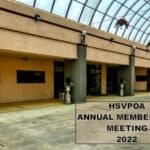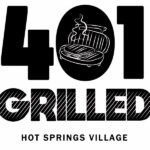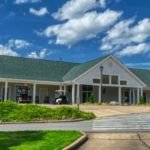After eight months of extensive and intensive study, the Hot Springs Village Future Revenue Analysis Task Force (FRATF) presented its recommendations to the Board of Directors at the Discussion Session on August 4, 2021.
This meeting was split into two parts with a short break in between. This report addresses part one of the meeting. Final task force recommendations are detailed in part two.
August-4-2021-FRATF-Presentation-Slide-1Board Members present:
- Joanie Corry, Chair
- Tucker Omohundro, Vice Chair
- Chris Jones
- Gary Belair
- Pam Avila.
Bob McLeod was absent.
The seventh Board seat remained unfilled.
Staff present:
- John Paul, Interim General Manager
- Coreena Fetterhoff, Corporate Treasurer, and Controller
- Katrina Heap, Administrative Assistant to the GM.
Stephanie Heffer, Director of Programs and Operations and Corporate Secretary was absent.
FRATF Committee Members present:
- Jeff Logren, Chair
- Larry Siener
- Keith Keck (in charge of Options Development Working Group) and Vice Chair
- Rolland White (involved with analysis of Public Works related items and some of the articles)
- Connie Shoemaker (Options Team)
- Cathie Moeller (on Finance and Planning Committee for two years)
- Phil Michaelson (Options Team and also worked with the Lakes Committee and some of the local groups).
Jeff Logren – Task Force Covers:
- In-depth look at task force financial analysis, highlighting certain areas of concern
- Projection/financial outlook
- Revenue analysis discussing ideas that did and did not meet criteria and why
- Three options for the Board
- General recommendations
- Options that FRATF feels address the financial challenges of Hot Springs Village
FRATF Mission Statement
FRATF “was given a task by the POA Board to analyze the past for lessons learned, our current budget, and most importantly, future financial requirements to sustain and maintain Hot Springs Village.
Our approach has been a data-driven analysis. We spent countless hours looking at the financial data, both revenue and expense side to fully understand the current situation and future outlook. Our financial analysis was done in close coordination with the Finance and Planning Committee (F and P). Additionally, we have been analyzing ideas to increase our revenue. These include expense reduction, other revenue source ideas, fees, and assessment ideas, both annual regular assessments and special assessments.
“We are now here to brief the POA Board and Property Owners on the results of our analysis and our recommendation.”
August-4-2021-FRATF-Presentation-Slide-3Initial Review
Initially, the task force gathered financial data from all sources. They then coordinated with the F and P Committee and began an in-depth review of the seven-year operations and maintenance budget forecast (O and M) provided by the POA staff. This included reviewing over 1,800 line items in the budget forecast, 100’s of written and oral questions, review of supporting documentation, and meetings to understand the needs and wants.
After the initial review, FRATF realized they needed to expand the time horizon beyond 2027 for some items like repairing and replacing culverts. “This was due to the fiscal practicality that these actions could not be accomplished by 2027 due to the magnitude of the challenge. Additionally, there are ongoing activities like maintaining our streets that will go on well beyond 2027.”
Prioritization
The major expenditures were prioritized into high, medium, and low categories.
FRATF then focused on the high-priority needs and determined when they could realistically be executed under our current financial model.
They used historical data to model projected growth rates for revenue and expenses.
Evaluation of Revenue Generation Ideas
Other Task Force members worked on developing revenue generation ideas. Property Owners, Staff, and others submitted more than 300 ideas.
Evaluation Criteria
In order to be data-focused, FRATF developed a set of evaluation criteria. Each idea was researched and scored using the evaluation criteria.
Some ideas were sent to the Rose Law Firm for legal review.
Meetings and Timeline
The task force met in each stage of the analysis in addition to having other meetings with POA committees.
FRATF also reached out to Cooper Communities, Inc. (CCI) for their input.
Experts were consulted in order to analyze some ideas and financial approaches which led to the development of options.
In March FRATF began sharing the Task Force analysis information to the community via emails and newspaper articles.
In April, the task force established a web page where their presentations, finished products, and links to YouTube videos were published.
In May and July, public forums were held.
August-4-2021-FRATF-Presentation-Slide-4Financial Analysis Presented by Larry Seiner
Example of Type of Analysis the Task Force Has Been Performing
Roads Analysis
A primary road has a life expectancy of 15 to 20 years. Primary roads generally carry higher and heavier loads of traffic than residential roads. This activity shortens the life of the primary roads.
Residential roads carry less traffic and a lighter load and can last 20 to 30 years before major maintenance is required.
If the road is subject to significant heavier traffic such as what happens during the construction of new homes, the lifespan of the road is decreased.
The Village has 472 miles of paved road.
The target of the Street Maintenance Department is to address 30 miles of road maintenance a year. This means, “we touch a given road on average once every 15 to 16 years.” In order to meet the target of maintenance on 30 miles of roadway every year, a street preservation program would require $1.2 million per year. (This is calculated in 2021 dollars.)
August-4-2021-FRATF-Presentation-Slide-5Have We Met The Goal of Addressing 30 Miles of Roads in Past Few Years?
“Let’s see how we have been doing over the last several years. The green line on the chart [below] takes the $1.2 million that we mentioned for road work in 2021 and takes it back in time to account for the time value of money. The red line is the actual Streets [Department] budget from 2013 to 2021. As you can see, back in 2013 and 2014, we were spending more to maintain our roads, but even that amount was on the decline. The situation worsened starting in 2015 when financial challenges forced us to cut the streets budget further. As you can see, in 2021, we only had $330,000 to allocate to streets maintenance work, putting us behind another $870,000. Since 2015, we are $3.8 million dollars behind in street maintenance work alone. But the streets department is not the only POA department with high priority needs.”
August-4-2021-FRATF-Presentation-Slide-6POA is Behind on More Than Street Repairs
“The data we are about to review comes from the seven-year operations and maintenance projections that were reviewed by the F and P Committee.” The table [below] shows you the breakdown of the POA divisions and the average amount of the additional funding they are projected to require over the 2022 to 2027 time frame.
Administration Division
- Administration
- Accounting
- Human Resources
- IT
- Member Services
- Risk Management
- Procurement
They will need about $334,000 more per year, mostly for investments and IT infrastructure.
Food and Beverage Division
The outsourcing of multiple POA-managed restaurants will reduce staffing, salaries, and the cost of food. That reduction is estimated to be about $966,000 a year.
Innovation Division
- Compliance (this includes gates)
- Development
- Marketing
- Permitting and Inspections
- Tourism
Innovation will need $141,000 more per year for gate upgrades and salary increases.
Public Safety Division
At the time these figures were compiled, Public Safety Division consisted of Animal Control and the Police and Fire Departments. They will need $384,000 more per year. This is primarily for salary increases.
Animal control is in the process of being transferred from the Compliance Division to the Innovation Division. But this change will have no impact on the aggregate costs of those two divisions.
Public Works Division
- Road work is only one of several responsibilities in this division. In addition to roads, culvert repairs, pavement, striping and the additional staff needed to take on the increased pace of road work in the Street Department is a part of this increase.
- Public Works also includes the Building Department. They need funding for roofs and HVAC repair and replacement.
- The Fleet Department needs funding to repair and replace our rolling stock.
- The Lakes Department needs funding to complete the lake dredging program.
- The Common Property and Forestry Department needs funds for roadside drainage and view clearance work.
- The Sanitation Department needs funds for equipment.
These total $3.48 million per year additional funding.
Public Utilities Division
Water and Sewer Departments require the replacement of aged and or outdated equipment, the replacement of water and sewer lines, and the expansion of a sludge pond at one of our sewer plants.
Public Utilities Divison needs about $1.45 million additional funding per year.
Golf Division
The Golf Division needs to replace the golf cart fleet, starting in 2023. There is also a need to replace golf course maintenance equipment in addition to planning and executing bunker rebuilds at two golf courses. They need $1.81 million per year in additional funding. (The chart shows $1.9 million.)
Recreation Division (Not Shown On Table)
This division does not look to be growing during the 2022 to 2027 time frame. As salary increases are expected to be offset by reduced levels of capital expenditures versus the 2021 budget.
Not Everything Could Be Accurately Estimated
“We have what we call, ‘known unknowns,’ in addition to the data that is in this chart.”
“A ‘known unknown’ is an item we know will occur but for which there is no accurate estimate of exactly when it is going to occur so it becomes very difficult to budget.”
Examples of ‘Known Unknowns’:
- Water tanks on east side to maintain proper water pressure. These cost between $1.5 and $2 million dollars to build. The estimated need for these is somewhere around 2025. The development rate on the east side will determine when these tanks are needed.
- Widening of DeSoto from the west gate to Callela Road. This $6 million dollar project will be needed at some point. Considering the current development rate within and just outside the west gate area of the village, combined with other less costly road management options like turn lanes, stoplights, stop signs, etc. we can mitigate the need for road widening for a ‘to be determined’ period of time.
Financial Data Analysis and the Problem
The bold black line running through the middle of the chart (below) is the revenue projection for 2022 to 2027. Our revenue growth rate is highly constrained because our regular assessment increases are tied to the Southern Region Consumer Price Index.
The gray area at the bottom of the chart contains the operating expenses for the village. This expense is related to vehicle maintenance, salaries and benefits, taxes, maintenance materials, and many other things needed to maintain the village.
As you can see, the growth rate of our protected operating expenses is growing more rapidly than our ability to generate revenue. The gray area at the bottom of the chart is closing on the bold black revenue line.
The red, yellow, and green bands indicate the investments needed to sustain and maintain all of the physical assets of the village (buildings, water, and sewer plants and lines, lakes, dam maintenance, equipment repair and replacement, and more).
The red area is a high priority. FRATF refers to the red area as the “red blob.”
Yellow is the medium priority. (Items that can be deferred for a period of time, but eventually these items will have to be addressed.)
The green area indicates the lowest priority items. These are the ‘wants’ or the ‘nice to haves.’
When you add the gray operational expenses to the high-priority red items, in 2022, we will be $5.1 million short.
By 2027, this number grows to more than $8 million and averages $6.7 million a year. This is the problem FRATF is trying to solve.
August-4-2021-FRATF-Presentation-Slide-8August-4-2021-FRATF-Presentation-Slide-9
Keith Keck on Ideas – Evaluation Criteria
FRATF received over 300 ideas on how to increase revenue or decrease expenses. The criteria for these ideas were as follows:
- Legal?
- Compatible with HSV Declaration/By-Laws?
- Feasible? Is it possible to do in HSV?
- Able to be administered? Would implementation of the idea cost more to implement than we would save?
- Reasonably acceptable to Property Owners?
The 300 plus ideas ended up being reduced to around 80, which were broken down into four categories.
- Expense reduction
- Other revenue sources
- Fees
- Assessments
Expense Reduction Ideas
- Employ multi-year procurement strategy (golf course mowers, pesticides)
- Buy used/leased vehicles (you can’t buy a used fire truck, but you could buy used pickups, etc.)
- Employ pooled equipment acquisition strategy (departments share equipment) This is already done to an certain extent.
Other Available Ideas
These ideas would be available if sufficient revenue is not generated from the next three revenue categories. (See Other Revenue Source Ideas Chart.) These are backup (last resort) ideas.
- Sell DeSoto Club (can sell buildings only with a membership vote)
- Sell Coronado Center
- Sell Police Training Center
- Sell Ponce de Leon/Woodlands Complex
- Outsource/contract police function to respective counties
Things to consider if any of the buildings are sold (consequences):
- Type of businesses that might come in
- Impact on traffic
- Requirement for outside visitor access
- Finding a buyer might be difficult
Outsourcing Police
This would replace our current police force with county sheriffs from both Saline and Garland Counties. One sheriff from each county would be stationed inside the village 24/7. A second sheriff would be stationed close outside both the east and west gates for a backup. This option would save $670,000 per year. Contracts for the sheriffs would still have to be paid.
Our police respond to things that some other officers might not do (snake in the garage, etc.).
August-4-2021-FRATF-Presentation-Slide-11-1Other Revenue Source Ideas
- POA Can Issue Water/Wastewater Bonds – This would cost Improved Property Owners $6 or $7 per month spread out over 20 years.
For the Other Revenue Source Ideas listed below, the Board should engage the POA staff and Volunteer Groups to assist.
- Increased marketing of POA amenity lots
- Outside water/wastewater treatment sales to folks right outside the east and west gates. This would have to be coordinated with Cooper Communities. There are consequences down the road as our facilities reach capacity.
- Timber/pine straw harvesting, tree nursery – This is not clear cutting, but rather selective cutting (proactive forest management).
- Outside police/fire funding through grants – because of our private community status, we are somewhat limited.
- Convention hosting – ask the POA to continue to encourage potential development of a hotel or lodging facility either right outside east or west gate or on reserve property. We know the POA does not need to be in the hotel business, but rather we would be encouraging outside investment.
- Commercialsponsorship (buildings, golf carts, etc.)
- Establish endowment fund for POA support – This needs a legal and tax review and then the establishment of a volunteer group to take the legal and tax guidance and develop an endowment fund to support Hot Springs Village.
Fee Ideas
- Increase golf amenity fees by $1/round.
- Create improved and unimproved amenity fees schedule – It is legal to have separate fees for improved and unimproved lot owners. Charge unimproved lot owners a small amount more for the use of the amenities.
- Increase amenity fees (tennis, pickleball, lawn bowling, etc. by $1.
- Implement new HSV Property Owner buy-in fee – Example: home $1500 – lot – $250. This concept is used in many communities across the United States. This fee would only apply when someone new to Hot Springs Village, buys a home, builds a home or buys a lot. This does not affect current property owners if they decide to buy a different home.
- Increase water/sewer/sanitiation charges 1%
Other Available Fee Ideas
- Increase assigned membership transfer fees to $100
- Increase car sticker fees by $5
- Third party sanitiation fees – The Townhouse Association has its own sanitation service. We could charge a third-party provider fee. This is allowed under our current governing documents.
- Review transfer and transaction tees (staff can make recommendations to the Board)
Assessment Ideas
- Increase the current two-tier rate by a fixed amount in years 2022, 2023, and 2024 (more on this later in this presentation)
- Increase the current two-tier rate by a percent amount per year from 2022 through 2026 – the value of this is it compounds the increase each year
- Special assessment for five years to be used for streets/culverts/striping, etc. – a special assessment must be for a specific reason. The special assessment option has the benefit of ensuring the money goes directly to a defined area
- Special assessment for five years to be used for water/wastewater purposes.
Unquantifiable revenue ideas
- Implement three-tier rate and increase assessment of existing tiers (Property Owners choosing the enhanced tier rate will receive enhanced benefits
- Unimproved – no change
- Basic improved – lower assessment increases to allow Property Owners to stay in good standing, but would have to pay higher amenity access rates
- Enhanced improved – pay a higher assessment and receive a discount for amenities *
- Additional $30/month charge on short-term rental property**
*Enactment of the enhanced improved tier poses a challenge as it is difficult to determine ahead of time how many people would use this option. A lot more analysis would need to be done before this option was put in place.
**Many communities are struggling with a similar option. FRATF believes this idea needs further study before implementation.
August-4-2021-FRATF-Presentation-Slide-14Ideas Not Meeting Criteria
Some examples of ideas not meeting criteria are:
- Closing a golf course – this would have a large impact on property values leading to legal action or POA buy-out of these properties.
- Incorporation – this would necessitate significant legal costs – both counties must be considered and would lead to duplicate staff – gate realignment requirements would be needed. This would give access to state funding but would be a financial challenge to the Village to implement. Cooper Communities asked us to make this a last resort.
- Implement a visitor access fee – administration of this would be done through the gate guard. Do we want to charge someone coming to church or charge for people visiting relatives? This idea would create a lot of work for the staff.
- Cutting the police force – property owners would not accept this option because the county sheriffs are already stretched thin.
- Staffing cuts – not feasible – additional public works crews are needed and potential pay increases are needed.
- Property value based assessment was determined to be illegal by Rose Law Firm.
- Grandfathering at current rates for folks unable to afford to pay more – would these folks lose their status of “property owners in good standing.” Property owners not in good standing lose their access to amenties.
- Single tier – unimproved Property Owners would not accept this. Implementation of this would mean an monthly assessment of $75.00 per property. This would most likely lead to an increased default rate on unimproved property.
August 4, 2021 FRATF Full Powerpoint Presentation to the HSVPOA Board
4-Aug-Board-Presentation-v18.1-Final-fratfThank you to the Task Force for the massive amount of hard work you put forth to compile this information. Also, thank you to the Property Owners for your suggestions and to the staff for all your hard work with this project. Also, much thanks to the Board of Directors.
By Cheryl Dowden, August 5, 2021
Click here to read part two of the FRATF report.
* * *
Thank you for reading. If you like, please comment below. We love to hear your opinion, but comments must be made using your first and last real name, or they will not be accepted. If you would like to submit an article for publication, please contact us through this website. Be sure to bookmark this website. Click here to visit the Hot Springs Village People Facebook Group.











Bonita Steers
08/05/2021 — 4:10 pm
I love the idea of creating volunteer groups who could take on some community cleanup, common area tasks, assisting with minor building maintenance/beautification projects, routine admin duties, where existing staff is stretched thin. Also, may be some opportunities for unpaid internships for our high school and Jr. college residents.
I might have missed a suggestion of small increases in permit fees which are relatively low now.
In most cases, we can be extremely proud of the professionalism, competence, and dedication of the HSV/POA staff we currently have serving this community.
Walter Newburn
08/06/2021 — 8:02 pm
Staffing cuts can be made. Not in public works or hourly positions. Look carefully at administration and management. That is where the savings come in compensation and benefits. If one looks at upward titles in the last few years you can clearly see the great increases in compensation. If you currently have 24 salary grades it would be excessive for the size of HSV. Enough said.
E